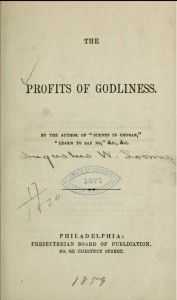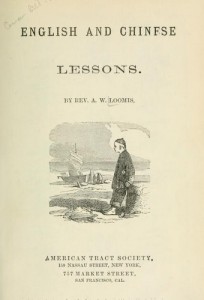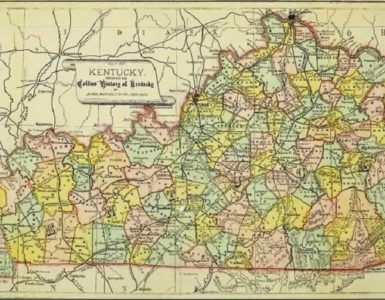Included in the writings of A. W. Loomis are some shorter works directed to readers including not only the nonbeliever but also Christians seeking instruction. One title is The Profits of Godliness, 1859, which is a simple, popular exposition of questions 36-38 of the  Westminster Shorter Catechism. Rev. Loomis explains each of the three answers by examining their component concepts. Considering the doctrine of justification by faith he said,
Westminster Shorter Catechism. Rev. Loomis explains each of the three answers by examining their component concepts. Considering the doctrine of justification by faith he said,
Joy flows from justification; for he that is pardoned will rejoice. There is ground for his rejoicing. He looks to Jesus as his Saviour, his Surety, who, by his blood, his obedience, his intercession, reconciled him to God. He believes on him, trusts in him, and believing, he rejoices with joy unspeakable, and full of glory (p. 35).
Loomis opens up the concepts of increase of grace, perseverance to the end, immediately passing into glory, perfection in holiness, awaiting the resurrection, resurrection in glory, open acknowledgement on the day of judgment, enjoying perfect blessedness, and then concludes his little book with the observation that “Surely godliness is profitable; it is a pearl of great price” (p. 120). When the book was published in 1859, Rev. Loomis had just started the ministry that would occupy the remainder of his life. He would spend his years working with the Chinese immigrants residing in California.
Augustus Ward Loomis was born September 4, 1816, in Andover, Hartford County, Connecticut, to Jerusha Brewster, who was descended from a member of Plymouth Colony, and Seba Loomis, who was of Huguenot descent. When Augustus was about eighteen months old the family moved to Cazenovia, New York. His father purchased a farm about a half a mile south of the village. At the age of eleven the boy began his preparation for college in the Oneida Conference Seminary in Cazenovia under the teaching of Rev. George Peck. As a young man he was not interested in becoming a minister, so he begged his parents to leave school and go into business more than a hundred miles to the east in Albany. However, despite Augustus’s interest in the business world, his parents’ prayed for his spiritual well being and the answer came when he professed his faith in Christ at the age of sixteen and united with the Second Presbyterian Church in Albany. The pastor at the time was William B. Sprague who may be recognized as the compiler of a multi-volume collection of ministers’ biographies titled, Annals of the American Pulpit. Thus, having his vocational plans changed, Augustus returned to Cazenovia to complete his preparatory studies for entry into the sophomore class of Hamilton College where he graduated in 1841 and then moved to New Jeresey to begin divinity studies in Princeton Seminary that fall.
 Augustus was licensed by the Presbytery of Albany during a meeting in Troy in 1843, and then immediately after his seminary graduation the same judicatory ordained him to the ministry, May 16, 1844. With three of his classmates, he was appointed by the American Board of Commissioners for Foreign Missionaries (ABCFM) to take the gospel of Christ to China. Just two days after his ordination, he married Miss Mary Ann Luce, and then thirty-five days after the wedding they sailed for China. They arrived in Macao on October 22 after a four-month voyage and resided there temporarily while studying Chinese. Their first home in China was the large island of Chusan which is just off the coast from Ningpo. For eighteen months, Rev. Loomis conducted a school for boys and preached twice each Sunday to English soldiers and foreign residents. Then, the couple moved to Ningpo where he was occupied with preaching on the street and in city chapels, organizing day schools, and ministering to the communities of the surrounding country. Six years of labor in a climate conducive to malaria resulted in broken health, so in 1850, the couple returned to America.
Augustus was licensed by the Presbytery of Albany during a meeting in Troy in 1843, and then immediately after his seminary graduation the same judicatory ordained him to the ministry, May 16, 1844. With three of his classmates, he was appointed by the American Board of Commissioners for Foreign Missionaries (ABCFM) to take the gospel of Christ to China. Just two days after his ordination, he married Miss Mary Ann Luce, and then thirty-five days after the wedding they sailed for China. They arrived in Macao on October 22 after a four-month voyage and resided there temporarily while studying Chinese. Their first home in China was the large island of Chusan which is just off the coast from Ningpo. For eighteen months, Rev. Loomis conducted a school for boys and preached twice each Sunday to English soldiers and foreign residents. Then, the couple moved to Ningpo where he was occupied with preaching on the street and in city chapels, organizing day schools, and ministering to the communities of the surrounding country. Six years of labor in a climate conducive to malaria resulted in broken health, so in 1850, the couple returned to America.
The spring of 1852 found Augustus and Mary Ann Loomis temporarily filling vacancies in the staff of the mission for the Creek Indian Nation in what is currently the state of Oklahoma. The superintendent had been compelled by ill health to resign. The Loomis family spent roughly a year caring for a boarding school of Creek boys and girls. He published a collection of his experiences and observations with the Creeks in Scenes in the Indian Country, 1859. They then moved then to the northeast of Oklahoma where Augustus served as a pastor and pulpit supply in St. Charles, Missouri, and across the Mississippi River in other churches in Illinois.
 In 1859, in response to an urgent appeal, they moved west where missionary work was undertaken among the more than one-hundred-twenty-thousand Chinese that had settled in California. He organized Sabbath schools, churches, and evening education programs. He also trained assistants and salesmen of religious books. One of the difficulties faced as he ministered to the Chinese was dealing with their persecution by the locals. Rev. Loomis found as he brought the gospel to the Chinese and built local churches that he was looked to as the advocate for their needs. His primary ministry was as the pastor of the First Chinese Presbyterian Church in San Francisco, which had been organized during the ministry of William Speer in 1853. The church had been without a minster for about two years when Pastor Loomis began shepherding his Chinese flock and some rebuilding of the congregation was required.
In 1859, in response to an urgent appeal, they moved west where missionary work was undertaken among the more than one-hundred-twenty-thousand Chinese that had settled in California. He organized Sabbath schools, churches, and evening education programs. He also trained assistants and salesmen of religious books. One of the difficulties faced as he ministered to the Chinese was dealing with their persecution by the locals. Rev. Loomis found as he brought the gospel to the Chinese and built local churches that he was looked to as the advocate for their needs. His primary ministry was as the pastor of the First Chinese Presbyterian Church in San Francisco, which had been organized during the ministry of William Speer in 1853. The church had been without a minster for about two years when Pastor Loomis began shepherding his Chinese flock and some rebuilding of the congregation was required.
Loomis’s life in California had been a busy ministry with only two or three visits back East and an extended rest in Europe. He was honored by his alma mater, Hamilton College, in 1873, with the Doctor of Divinity. Augustus Ward Loomis died in San Mateo on July 26, 1891, of heart failure after thirty-two years of ministry to the California Chinese. Mary Ann predeceased him in 1867, but then in 1873, he married Mary M. Akers who was a widow and his only survivor because neither marriage was blessed with children. Rev. Dr. Thomas Fraser, a life-long associate of Dr. Loomis said of his friend that…
a marked and strong feature in the character of Dr. Loomis was thorough conscientiousness. Nature gave him a strong, brave and manly soul. Divine grace and truth had quickened, purified and enlightened his conscience, making it exceedingly sensitive and prompt in its response to the demands of duty. With him the one supreme thing was duty. He sought not pleasure or prominence. He was not ambitious, had no aspirations beyond doing his work, cherishing his faith, pressing toward the mark of the prize of the high calling of God in Christ Jesus. His religion before the world consisted in the faithful performance of duty.
Dr. Fraser’s kind words regarding the life, faithfulness, and persistence of A. W. Loomis bring to mind the concluding words of The Profits of Godliness, which were, “Surely godliness is profitable; it is a pearl of great price”.
BARRY WAUGH
Sources—Two sources for California Presbyterianism are James S. McDonald and James L. Wood’s book, California Pioneer Decade of 1849: The Presbyterian Church, San Francisco: The Hansen Co., 1922, which was reprinted in 1981 by Pioneer Printing of Fresno, California; and Edward A. Wicher, The Presbyterian Church in California, 1849-1927, New York: Frederick H. Hitchcock, 1927; however, neither one of these books was very helpful for information regarding Loomis. Most of the biographical information was taken from the Princeton Seminary necrological report published by the alumni association and from the obituary in The Hamilton Literary Monthly, pages 85-86, vol. 26, no. 2, 1891.
Notes—In addition to the two books already mentioned, Dr. Loomis published Learn to Say No, 1856, Scenes in Chusan, 1857, How to Die Happy, 1858, The Child a Hundred Years Old, 1859, Confucius and the Chinese, 1867, and his book for teaching English to the Chinese, Chinese and English Lessons, 1872.





